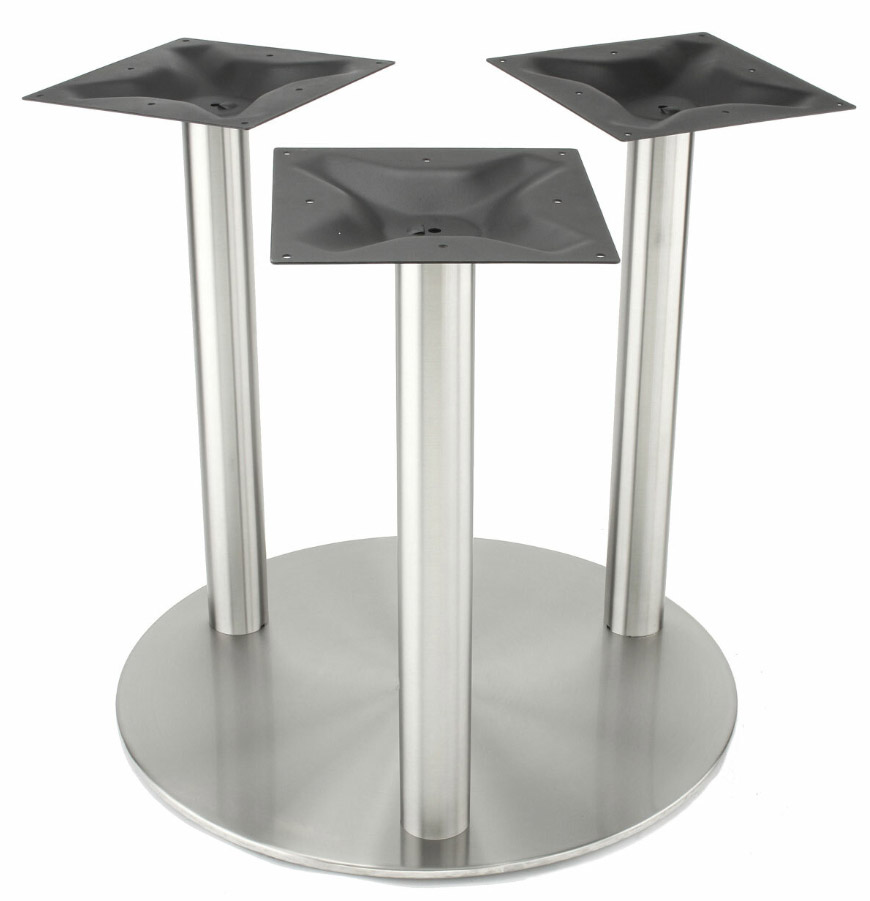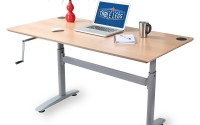How To Clean Stainless Steel Table Legs and Bases
Stainless steel is a fantastic material for your metal table legs and metal table bases because it is easy to clean and has a shiny finish that can last many years. But like any material, without the right prevention, care, and maintenance, stainless steel can soon experience levels of corrosion that can cause unsightly stains and rust. How can you clean and protect stainless steel furniture to ensure it stays shiny and sturdy?

How To Prevent Problems With Stainless Steel
Prevention is the key to working with stainless steel. If your stainless steel table base or legs are staying outside, they are going to be exposed to the elements, and coating it with protective spray is a good idea because it can maintain color, shine, and strength.
Protective spray brands such as Nycote can help with table legs and bases. However, it’s important to know that it’s not recommended for stainless steel products that come into contact with food. But if you want to prevent problems, periodic cleaning can work wonders in preventing corrosive particles from building up, and once a week is usually enough to keep on top of most stainless steel problems.
The Best Cleaning Methods for Stainless Steel
As stainless steel is a durable material, regular care is essential to maintain the shine. There is a whole manner of external forces that can cause damage to your stainless steel’s shine, such as oil, fingerprints, or dirt. But this is where you can utilize some of the best cleaning methods based on what you have access to, so you can learn how to clean stainless steel appliances naturally. A few natural approaches include the following:
Glass Cleaner
In a restaurant or backyard environment where there are kids crawling around, messy fingerprints can inevitably find themselves on your table bases and legs, but you can use glass cleaner and wipe it off with a dry cloth or paper towel in a circular motion.
If you are wondering can you clean stainless steel with Windex, you can, but you’ve got to be very careful. Because Windex contains ammonia, this is a very harsh substance, and while ammonia can cause damage to surfaces when used by itself, when it is diluted with water it can be a very powerful cleaning agent.
Dish Soap
Dish soap is another effective tool as it removes dirt, fingerprints, and residue with ease. You can make a simple solution of soap and warm water, but depending on the level of the stain you may wish to add more soap. Apply the water to a soft cloth and rub in circular motions.
Vinegar
White vinegar and olive oil are a fantastic combination. The vinegar’s acidity cuts through any grease and leaves an attractive shine; applying a few drops of white vinegar and wiping using an even amount of pressure with a paper towel can easily remove grease. Once you have wiped the surface, polish the cleaning spot with a bit of olive oil on a microfiber cloth to create a great shine.
It’s important to use white vinegar, the kind that you use in food and not cleaning vinegar (a different product altogether) as it is about 20% more acidic and can leave stains or pitting.
Flour
Another great natural method is to use flour. Flour is in abundance in any kitchen, but it works so well because it absorbs grease and dirt without leaving any residue. Just make sure you use a dry cloth and wipe in a circular motion afterward until the surface is clean.
What To Avoid When Cleaning Stainless Steel
When learning how to clean stainless steel, you need to know what to clean stainless steel with. Here are some of the best practices you need to avoid so it leaves a streak-free shine:
Do Not Use Steel Wool or Brushes
When trying to get rid of rust any brush or steel wool will scratch the surface, making it more susceptible to staining and rusting.
Do Not Use Bleach or Any Cleaners That Contain Chlorine
The high level of abrasion that comes from bleach and chlorine-based cleaners will cause a lot of damage to the stainless steel and will stain it, taking out that shine.
Be Careful What Tap Water You Use
Tap water is very good at cleaning, but it can leave spots or stains if it is particularly harsh. When in doubt, you should use distilled, filtered, or water that has been pre-boiled in a kettle to make sure the impurities have been removed.
Never Leave Solutions to Dry
When cleaning stainless steel surfaces, do not leave cleaning solutions or water to dry on the stainless steel. This can create a dull finish and may leave permanent stains.
Simple Tips When Cleaning Stainless Steel
Cleaning stainless steel is straightforward when you know what works and what doesn’t. Here are a few other things that you should consider when cleaning stainless steel:
Look at the Manual
Before you start cleaning any stainless steel surface it is a good idea to check the recommendations by the manufacturer. If you don’t have the manual, you should be able to find it online.
It is essential to check the directions for your specific item of furniture because there are different grades of stainless steel that are not as durable, and some can be treated with a clear coat finish which could be stripped away by certain cleaning products.
Go With the Grain, Not Against It
Similar to cleaning wood, stainless steel has a groove. Look at the striations on the surface of the table leg and base, and wipe in that direction.
Rub Out Rust With Baking Soda
Any rust on stainless steel can be removed by making a paste out of baking soda and water. Let it sit for 20 minutes, and scrub the area with a damp cloth, making sure that you work with the grain and fully rinse and dry it afterward.
Stainless steel is one of the most aesthetically pleasing, corrosion-resistant, and sturdy materials out there. They provide long-term value to households and businesses alike, but if you want to make sure your own investment goes further, knowing how to clean stainless steel table legs and bases with the right level of care, prevention, and maintenance will ensure that they last much longer.


